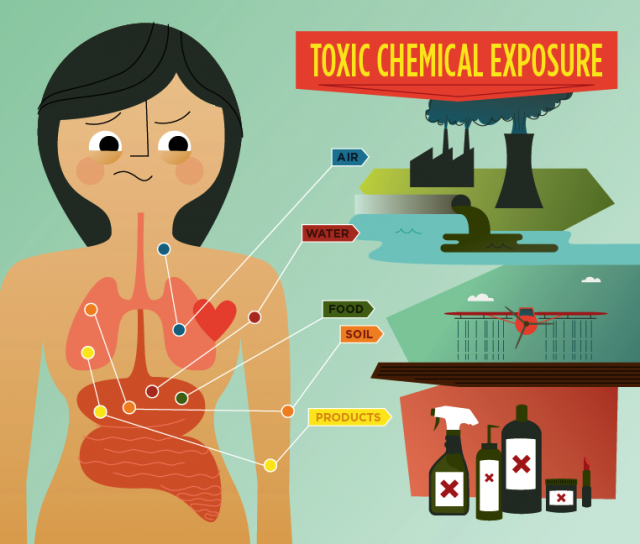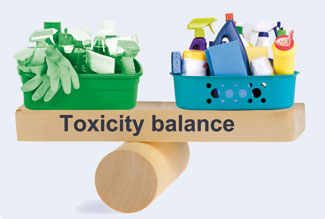Even if you carefully monitor what you eat, and pay close attention to the household products and items you purchase, your chance of being exposed to hazardous toxins is still quite high. Lead, arsenic, mercury, PCBs, flame retardants, and an array of other chemicals linked to cancer, birth defects and neurological diseases are well represented in most people’s bloodstream.
These dangerous chemicals and toxins are in the air you breathe, the water you drink, the food you eat, your home and workplace, and the products you use. Over the last 50 years, from 70,000 to 100,000 different chemicals have been introduced into the world‘s markets with about 1,500 new ones added each year.
Numerous clinical studies reveal that common and dangerous toxins are stored in the bodies of a large percentage of the population –- within organs, fluids, tissues, and circulation. In many of the cases studied, toxic body burden exceeded safe exposure limits as set by the Environmental Protection Agency, as these toxins are closely linked to a number of chronic illnesses, developmental conditions, and behavioral problems. Toxins wreak havoc by causing chronic inflammation, DNA mutations, oxidative stress, the disruption of cell signaling, and other critical damage.
You can take action to prevent and reduce your exposure to these harmful toxins right now! That would include switching to non-toxic and natural alternatives for items that you use on your body, in your home and around your yard, to start.
- Estimates show most Canadians have somewhere between 400 and 800 chemicals stored in their bodies, typically in fat cells. Because effects from exposure to toxins are difficult to identify, it can be years before problems from exposure manifest themselves as a disease or chronic ailment.
Toxins in Your Home and Workplace
Many potential toxins are lurking within your home. Toxins can be found in furnishings, flooring, paint, air fresheners, cleaning products, the water you drink, and the air you breathe. Commercial interests often override health concerns associated with many products, in part because related health problems may take years to develop and be difficult to assign cause.
The workplace can also be a dangerous environment. It is a place in which we can encounter many chemicals and products that are also found in the home, that have the potential to cause human harm. There have been countless articles written on both “Sick Building Syndrome” and “Occupational Asthma.” Under these two modern diagnoses, people have complained of a variety of symptoms including watery eyes, runny nose, headaches, dizziness, nausea and tightening sensation in the chest. The curious thing about most of these symptoms is that they have a distinct pattern of getting worse while in the work environment and significantly better over vacations or weekends.
The Most Common Toxins Found in Homes and Workplaces Today
- Volatile Organic Compounds: VOCs are a group of chemicals that vaporize easily and bring gas pollutants into the home from a variety of sources. Risks: Eye and respiratory tract irritation, headaches, dizziness, visual disorders, and memory impairment; chronic exposure increases the risk of cancer, liver, kidney and central nervous system damage. Sources: New carpets and home furnishings, interior paints, particle board, plywood and pressed wood products, new plastics and electronics, deodorants, cleaning fluids, varnishes, shampoos and cosmetics, dry cleaned clothing, moth repellants, air fresheners, and during the burning of wood stoves and tobacco products.
- Mold and other Fungal Toxins: One in three people have had an allergic reaction to mold. Mycotoxins (fungal toxins) can cause a range of health problems with exposure to only a small amount. Risks: There is no consensus among scientists about the health hazards of mycotoxins. Mycotoxins may have toxic effects ranging from irritation of mucous membrane, to suppression of the immune system and cancer. Sources: Contaminated buildings, damp areas with frequent temperature changes, airborne particles from furnace blower or air conditioning unit.
- Phthalates and PVC (polyvinyl chloride): Risks: Endocrine system damage (phthalates chemically mimic hormones and are particularly dangerous to children). Researchers have associated pregnant women’s exposure to phthalates with adverse effects on the genital development of their children. These risks may even prevail in low-dose exposure. Sources: Plastic wrap, plastic bottles, plastic food storage containers, which can leach phthalates into our food. PVC in some consumer products such as vinyl flooring, drapes and wall-coverings, baby’s toys, shower curtains, blow-up air mattresses, cosmetics and fixatives
Indoor air can have higher concentrations of toxins than outdoor air. Ironically, these chemical toxins come from the products we use to make our lives better.
A few simple strategies which can be taken to reduce exposure to toxins in the home:
- Know the most common toxins that are found in homes today
- Find safe substitutes, mitigate the hazard or do without the product
- Ventilate your home regularly, especially during winter months.
Did You Know?
Environmental chemicals are a contributing factor to the obesity epidemic. Low dose, chronic exposure to certain compounds may be the source of endocrine and metabolic disruption contributing to the problems people are having with weight gain.
Strategies to Eliminate Toxins in Your Home
- Only use natural cleaning products in your home. You can make your own or purchase from health food stores.
- Establish a “no shoe” policy in your home. This will reduce toxins and pesticides brought into your home from outside.
- Avoid using chemical pest control products. Look for safe, non-toxic alternatives.
- Use toxin reducing house plants. Certain house plants are useful in cleaning the air inside your home.
- Change or clean your furnace or A/C filters at least every 1-3 months depending on use.
- Switch over to natural brands of toiletries including toothpaste, antiperspirants and cosmetics.
- Avoid using artificial air fresheners, dryer sheets and fabric softeners as these will pollute the air in your home.
- Avoid using lawn care chemicals to prevent residue from being tracked into your home.
- Have your tap water tested and if contaminates are found, install water filters.
- Use low-VOC paints, caulks, sealants, finishes and carpeting
- Ventilate all year round to bring fresh air into your home.
Toxins in Personal Care Products
The skin is your largest organ, what you put on it is absorbed into your bloodstream!
The average woman uses over 15 personal care products daily, the average man about 6. Each product containing a dozen or more chemicals! Many of these chemicals are carcinogens, neurotoxins and contain reproductive toxins! See that long list of ingredients on the back of the bottle? Some probably aren’t as safe as you’d hope.
The majority of people wash their hair daily with some of these toxic ingredients namely: Sodium lauryl sulfate, Parabens, and propylene glycol. Sodium Lauryl sulfate is a surfactant (industrial strength), Parabens (preservatives that mimic estrogen, and propylene glycol, moisture retainer (cosmetic form of antifreeze). Why consciously put those in your hair, skin and mouth daily?
Perhaps you’ve reasoned that a little poison is okay and continue using commercialized products. Seeking out responsible skin care products is like making food choices. Just like food, there are alternatives to toxic products. By reading labels, avoiding harmful ingredients this might help you feel a little healthier, contributing to wellness, while reducing unintended consequences of compounded toxins in your body and environment. A win-win!
For more information about toxins in personal care products go to the Environmental Working Group’s Skin Deep Cosmetics Database: www.ewg.org/skindeep
Environmental Toxins – A Naturopathic Perspective
Toxins commonly come in the form of heavy metals, chemicals and from breakdown products produced by metabolism. The body is constantly working to neutralize and eliminate them. A toxic overload happens when the body can’t remove these toxins and they start building up in the cells. Symptoms of toxicity can range from fatigue, muscle aches, joint discomfort and pain, eczema, headaches, or indigestion to more severe diseases including cancer and Parkinson’s Disease. From a naturopathic perspective, the main goal is to eliminate exposure to harmful materials while supporting the body to detoxify and eliminate these harmful materials. Consuming organic food allows us to avoid many of the pesticides, herbicides, synthetic hormones and antibiotics present in our food system. Switching to safer cleaners and personal care products prevents us from being exposed to chemicals that can contribute to cancer and hormone dysfunction. The concepts of “detoxification” and “cleansing” have also been gaining popularity in modern times with the increasing number of toxins surfacing in our environment and a corresponding decrease in health of our population. Although we can’t avoid everything, there is much we can do to increase our awareness and support our bodies to eliminate toxins. Get informed, take action, and if you need extra help your naturopath is here to steer you in the right direction!
Eliminating Toxins
We know toxins are everywhere and much of them we can’t avoid… so what do we do to stay healthy? Here are a few tips to get you started:
- Get tested – A “Hair Mineral Analysis” can test for buildup of toxic heavy metals including lead, mercury, arsenic and cadmium. An “Environmental Pollutant Panel” is also available, which is an at-home urine test measuring buildup of phthalates, parabens and volatile organic compounds. See the book “Slow Death by Rubber Duck” for more information.
- Stimulate detoxification and elimination – Talk to your naturopath about a comprehensive and individualized detoxification program. This typically includes 3 weeks of dietary changes, supplements, naturopathic prescriptions and other detoxifying procedures. If you don’t know where to start or want to make a dramatic change in a short period of time, this is the right choice for you!




